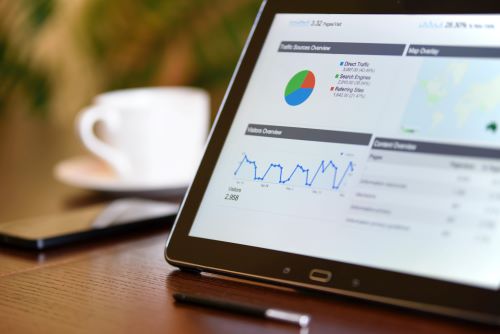Web analytics is the process of analysing a website’s user behaviour. It assesses the way visitors interact with the site. This is done by tracking, collecting, measuring, analysing, and reporting data.
Data analytics is the process of examining data sets to find meaning, trends, insights, answers, conclusions, and other useful information. This is done by cleaning, transforming, and modelling data.
Did you catch the difference between web and data analytics? Web analytics focuses on understanding websites. Data analytics works with data sets that can be extracted from websites, solutions, channels, platforms, or anywhere else.
But that’s only a technical explanation. There’s a lot more to these disciplines. Let’s get into why they’re so popular and what they mean for business today.
Why data and web analytics are vital in our digital world
Web and data analytics are the only way to find out what’s happening on a website or platform. This is critical for businesses, charitable organizations, governments, and anyone else using the web with intention.
Businesses will analyse their own websites, their competitors, and third-party platforms like search engines and social media channels. Analytics gives you two things:
- Insights on how visitors and users interact with a website or platform
- Insights on the visitors and users themselves
That sounds simplistic. However, you can get an enormous amount of information through web and data analytics.
The results usually fall under lead generation, conversion, engagement, audience demographics, audience, behaviour, and campaign data. The data analysed can include:
- Page views
- New visitors
- Returning website visitors
- Most frequently visited pages
- Traffic sources
- Visitor bounce rate
- Bounce rate causes
- Website traffic by channel
- Conversions by channel
- Best performing channel
- Visitor demographics (age, country, profession, device, browser)
- Email open rates
- Social media views
It’s the analyst’s job to understand what data is important and how each result fits into the big picture.
The business benefits of using web and data analytics
There’s one dominant benefit of using data analytics: better, more informed, and more accurate decision-making.
You get tons of data, information, metrics, and insights. And this helps you to better understand the audience, marketplace, and customer. This understanding ultimately improves decision-making.
Web and data analytics are practical in nature. Companies use these disciplines to gain useful information that can be directly applied.
Analytics helps businesses understand and continually improve their customer’s experiences, align themselves with the marketplace, improve their marketing, improve their marketing ROI, and achieve other desired business outcomes.
They gain clarity around the market, internal performance, and financial outcomes.
The four kinds of web and data analysis
Data analytics fall under four categories: descriptive, diagnostic, predictive, and prescriptive.
Descriptive analytics describes what’s happened. It finds statistics, trends, and patterns existing within a data set. This kind of analytics gives you KPIs and metrics. For example, it can provide the number of sign-ups or the ROI of a search engine advertisement.
Diagnostic analytics tells why something happened and what’s gone wrong. It looks to find the likely causes for a data value or anomaly. Businesses use this to understand what’s going on in the company and marketplace. For example, advanced analytics might tell a mail order cookie company that a region’s sales dropped off because there was flu in the area and not because customers didn’t like a new ad.
Predictive analytics examines data sets to determine what may happen in the future. It uses a set of historical data to determine the most likely future outcomes and probabilities. Businesses can use this to find out if a certain prospect is likely to convert and be a valuable repeat customer.
Prescriptive analytics determines what actions are most likely to bring about the desired result. It gives actionable recommendations based on complex machine analytics. Businesses use prescriptive data analytics to find the best paths to achieving various business objectives. For example, this method can tell a business what email marketing offer is likely to win back a lost customer.


What types of data can be analysed?
Web and data analysts work with data from social media, search engines, websites, advertising campaigns, and other platforms. The data can be broken down into quantitative and qualitative data.
Quantitative data refers to numerical data that can be counted or measured. It’s discrete and objective. The quantitative data that analysts work with includes:
- Number of website visitors
- Sales numbers
- Revenue percentage changes
- Ad click-throughs
- Email newsletter sign-ups
- Email click-through rates
Qualitative data refers to conceptual and descriptive data that can be observed but not measured. Qualitative data is often referred to as unstructured. The qualitative data that analysts work with includes:
- Social media comments
- Product review language
- Written survey responses
- Social media sentiments
A day in the life of a web and data analyst
Web analysts work everywhere. You can find them at family businesses, small companies, charities, large multinational enterprises like Coca-Cola and IBM, or working for themselves.
Data analysts have a lot to take care of no matter where they work. A typical day in their working life might include:
- Compliance Checks – Working with data means being aware of and compliant with stringent worldwide privacy laws, guidelines, frameworks, and regulations. Web and data analysts are usually responsible for keeping their businesses compliant. A day’s work might include handling data deletion requests.
- Strategic Planning – Many web analysts direct the business’s analytical strategy. This can include analysing the best social media channels to run ads on or finding the most profitable ad demographics.
- Web Analytics – An analyst has to check on the regular website and social media analytics along with any current campaigns.
- Email List Analysis – Email lists have to be maintained over time. An analyst’s tasks might include analysing the number of bounced emails, finding the best opt-in channels, and looking at what email subject lines are the most profitable.
- Seasonal Campaign Result Forecasting – Forecasting is part of predictive analysis. A data analyst may look back at prior results to predict how well a new campaign will do and what actions should be taken to optimise its results.
- Presentation – Data analysts must compile their recommendations into engaging data presentations. This shouldn’t be boring. Data analysts routinely include storytelling principles when visualising and presenting data. It should be well-organized and easy for other people to understand.
How to become a web or data analyst
Data and web analysts provide business leaders with critical decision-making information. Their contributions are trusted, respected, and based on a solid education in analytical techniques and best practices.
The core data analytics education includes learning data collection, processing, cleansing, analysing, management, forecasting, visualisation, and reporting. Understanding these techniques requires learning about machine learning and using artificial intelligence.
A comprehensive course will include marketing training so that you know how to apply and use your insights within the business.
If you want to build a serious long-term career, you should also learn agile thinking skills, professional problem-solving, and workplace adaptability.
Becoming a data analyst requires a comprehensive educational program. It used to be difficult to access this level of education. When data analytics was first emerging as a professional field, these programs were reserved for prestigious four-year and graduate educations.
Things are much more accessible now. Today, you can become a web and data analyst by taking a course with a reputable online educator like Digital Academy.
Study web and data analytics with Digital Academy
Web and data analytics are some of the most valued digital business skills. You can start learning those today by enrolling in a course with Digital Academy – the exclusive regional partner of the Digital Marketing Institute.
Our graduates are already working for companies like Google, Meta (Facebook), HubSpot, Nike, and IBM.
Want to join them? Step forward into your new career and enrol today.




